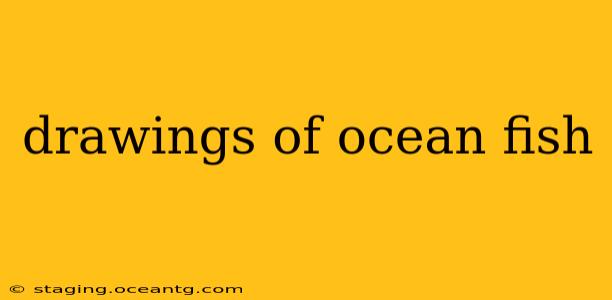Dive into the Depths: A Colorful Collection of Ocean Fish Drawings
The ocean, a vast and mysterious realm, teems with a breathtaking diversity of life. Among its most captivating inhabitants are the fish, boasting an incredible array of shapes, sizes, and colors. This exploration delves into the art of drawing ocean fish, offering inspiration and guidance for both aspiring and experienced artists. Whether you're capturing the sleek elegance of a tuna or the vibrant hues of a parrotfish, drawing these creatures offers a unique opportunity to connect with the beauty of the marine world.
What are the easiest ocean fish to draw for beginners?
For beginners, simpler fish with less intricate details are ideal starting points. Think about rounder shapes, fewer fins, and solid, rather than patterned, colors. Good choices include:
- Clownfish (Anemonefish): Their iconic orange and white stripes are easy to replicate, and their generally oval body shape is simple to construct.
- Goldfish: The classic goldfish, with its familiar shape and minimal details, provides excellent practice in proportion and basic shading.
- Beta Fish (Siamese Fighting Fish): While their flowing fins add a level of complexity, the basic body shape is relatively straightforward. Focusing on the flow of the fins is a great way to practice linework and movement.
- Angelfish (certain species): Some angelfish species have relatively simple body shapes, making them good starting points. Look for those with less intricate fin designs.
Start with basic shapes like circles and ovals to form the body, then add fins and details gradually. Don't be afraid to simplify!
How do I draw realistic ocean fish?
Achieving realism in fish drawings requires attention to detail and understanding of their anatomy. Here are some key tips:
- Study References: Use photographs or videos of real fish as references. Observe the shapes, proportions, and placement of fins, eyes, and mouths. Pay attention to the subtle curves and variations in their bodies.
- Understand Anatomy: Learn about the basic skeletal structure of fish to understand how their bodies move and flex. This will help you draw more dynamic and believable poses.
- Mastering Light and Shadow: Use shading and highlighting to create depth and dimension. Observe how light reflects off the scales and how shadows fall across the body. This is crucial for achieving realism.
- Practice, Practice, Practice: The more you draw, the better you'll become at capturing the nuances of fish anatomy and movement.
What are some different techniques for drawing ocean fish?
Various drawing techniques can enhance your ocean fish drawings:
- Pencil Sketching: This is a great starting point for creating detailed anatomical studies. Experiment with different pencil grades (e.g., H for lighter lines, B for darker lines) to achieve varied tones.
- Colored Pencils: This allows for precise color control and subtle shading, ideal for capturing the vibrant colors of tropical fish.
- Watercolor: This technique is perfect for capturing the fluidity and movement of fish in water. Experiment with washes and layering to create depth and transparency.
- Ink Drawing: Ink can be used for bold lines and dramatic effects. Experiment with different pen nibs to create varied line weights and textures.
What are some fun and creative ways to draw ocean fish?
Beyond realism, let your creativity flow!
- Cartoon Fish: Simplify shapes and exaggerate features to create whimsical and fun characters.
- Stylized Fish: Develop your own unique style by experimenting with different line weights, textures, and color palettes.
- Fish with Human-like Features: Give your fish personalities by adding human-like expressions or clothing.
- Surreal Fish: Combine elements from different fish or add fantastical features to create unique and imaginative creatures.
Drawing ocean fish is a rewarding and enjoyable experience. By combining observation, practice, and creativity, you can produce stunning artwork that captures the beauty and diversity of these fascinating creatures. So grab your pencils, paints, or digital tools and embark on your underwater artistic adventure!
